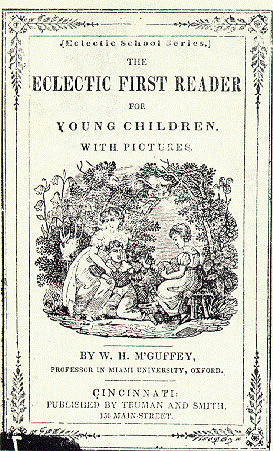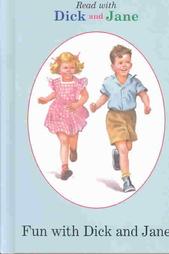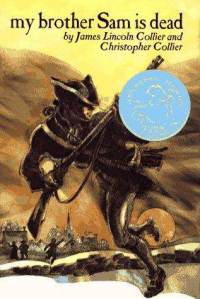
The Cat in the Hat is a 1957 children's book written and illustrated by American author Theodor Geisel, using the pen name Dr. Seuss. The story centers on a tall anthropomorphic cat who wears a red and white-striped top hat and a red bow tie. The Cat shows up at the house of Sally and her brother one rainy day when their mother is away. Despite the repeated objections of the children's fish, the Cat shows the children a few of his tricks in an attempt to entertain them. In the process, he and his companions, Thing One and Thing Two, wreck the house. As the children and the fish become more alarmed, the Cat produces a machine that he uses to clean everything up and disappears just before the children's mother comes home.

The Eclectic Readers were a series of graded primers for grade levels 1–6. They were widely used as textbooks in American schools from the mid-19th century to the early 20th century, and are still used today in some private schools and homeschooling.

In education, a curriculum is broadly defined as the totality of student experiences that occur in the educational process. The term often refers specifically to a planned sequence of instruction, or to a view of the student's experiences in terms of the educator's or school's instructional goals. A curriculum may incorporate the planned interaction of pupils with instructional content, materials, resources, and processes for evaluating the attainment of educational objectives. Curricula are split into several categories: the explicit, the implicit, the excluded, and the extracurricular.

Dick and Jane are the two main characters created by Zerna Sharp for a series of basal readers written by William S. Gray to teach children to read. The characters first appeared in the Elson-Gray Readers in 1930 and continued in a subsequent series of books through the final version in 1965. These readers were used in classrooms in the United States and in other English-speaking countries for nearly four decades, reaching the height of their popularity in the 1950s, when 80 percent of first-grade students in the United States used them. Although the Dick and Jane series of primers continued to be sold until 1973 and remained in use in some classrooms throughout the 1970s, they were replaced with other reading texts by the 1980s and gradually disappeared from school curricula.
Zerna Addas Sharp was an American educator and book editor who is best known as the creator of the Dick and Jane series of beginning readers for elementary school-aged children. Published by Scott, Foresman and Company of Chicago, Illinois, the readers, which described the activities of her fictional siblings, "Dick," "Jane," "Sally," and other characters, were widely used in schools in the United States and many other English-speaking countries for nearly forty years. The series, which included such titles as We Look and See, We Come and Go, We Work and Play, and Fun with Dick and Jane, among others, was marketed until 1973 and used the look-say method of teaching reading.
Basal readers are textbooks used to teach reading and associated skills to schoolchildren. Commonly called "reading books" or "readers" they are usually published as anthologies that combine previously published short stories, excerpts of longer narratives, and original works. A standard basal series comes with individual identical books for students, a Teacher's Edition of the book, and a collection of workbooks, assessments, and activities.
Accelerated Math is a daily, progress-monitoring software tool that monitors and manages mathematics skills practice, from preschool math through calculus. It is primarily used by primary and secondary schools, and it is published by Renaissance Learning, Inc. Currently, there are five versions: a desktop version and a web-based version in Renaissance Place, the company's web software for Accelerated Math and a number of other software products. In Australia and the United Kingdom, the software is referred to as "Accelerated Maths".

Weekly Reader Publishing was a publisher of educational materials in the United States that had been in existence for over 100 years. It provided teaching materials to elementary and secondary schools that was used by more than 90 percent of that country's school districts.

East Aurora High School,, is a public, four-year high school located in Kane County, at the corner of Smith Boulevard and Fifth Avenue in Aurora, Illinois, a western suburb of Chicago, Illinois. It is the only high school in East Aurora Public School District 131.

My Brother Sam Is Dead is a 1974 young-adult historical fiction novel by James Lincoln Collier and Christopher Collier. The book takes place in Redding, Connecticut during the American Revolution, and is told from the perspective of a young boy, Tim Meeker. The novel details Tim's brother, Samuel, and his desire to fight for the Patriots, despite his father's opposition to the war. Ultimately, Tim is forced to decide between siding with his brother and joining the colonies’ war efforts, or abiding by his father's anti-war wishes.

Janet and John is a series of early reading books for children, originally published in the UK by James Nisbet and Co in four volumes in 1949–50, and one of the first to make use of the "look and say" approach. Further volumes appeared later, and the series became a sales success in the 1950s and 60s, both in the UK and in New Zealand. By the 1970s, the books were considered outdated, and several updated versions were issued. Facsimiles of two of the original volumes were reprinted in 2007 to cater for the nostalgia market.
Sandra Stotsky is Professor emerita in the Department of Education Reform at the University of Arkansas, and held the 21st Century Chair in Teacher Quality. Her research ranges from teacher licensure tests, e.g., (1), coherence in the literature and reading curriculum, e.g., (2), and academic achievement in single-sex classrooms, e.g., (3) to critiques of Common Core’s standards in English language arts, e.g., (4) mathematics.(5), and US History and civic education (6), and other aspects of the Common Core project, e.g., (7), and to reviews of books in education, e.g., (8) She is an advocate of standards-based reform and strong academic standards and assessments for students and teachers.
William S. Gray was an American educator and literacy advocate, who was commonly referred to as "The father of Reading".

Scott Foresman was an elementary educational publisher for PreK through Grade 6 in all subject areas. Its titles are now owned by Savvas Learning Company which formed from former Pearson Education K12 division. The old Glenview headquarters of Scott Foresman is empty as of August 2020, and Crain's Chicago Business reported that the broker hired to sell the property had missed a mortgage payment.
The use of comics in education is based on the concept of creating engagement and motivation for students.

MicroSociety, Inc is a non-profit organization located in Old City, Philadelphia that has been preparing children to compete in the global economy for more than 20 years and is operating in over 300 schools across the United States.

Seigakuin Atlanta International School was an international, private, Christian elementary school located in Peachtree Corners, Georgia, United States, northeast of Atlanta, It is an affiliate to Seigakuin University, and therefore is a Shiritsu zaigai kyōiku shisetsu or an overseas branch of a Japanese private school. It was the only school in Greater Atlanta to have its curriculum accredited by the Japanese Ministry of Education. From its founding in 1990 until 2003, the school had been located on the property of Oglethorpe University in Brookhaven, DeKalb County. In 2003, the school moved to its final location. From April 2008 until the school's 2018 closure, Minako Oki Ahearn served as the principal.
Pop Culture Classroom, is a nonprofit organization based in Denver, Colorado, that teaches literacy and the arts through alternative approaches to learning and character development. The organization creates educational programs for underserved youth, schools. and communities using comic books, graphic novels and related media to inspire passion for reading, art, and learning.
Mabel O'Donnell (1890–1985) was an author of popular children's literature, mostly basal readers that helped young readers build stamina and endurance. O'Donnell is best known for the Alice and Jerry and Janet and John series. Books by O'Donnell sold more than 100 million copies around the world.
Why Johnny Can't Read—And What You Can Do About It is a 1955 book-length exposé on American reading education by Rudolf Flesch. It was an immediate bestseller for 37 weeks and became an educational cause célèbre. In this book, the author concluded that the whole-word (look-say) method was ineffective because it lacked phonics training. In addition, Flesch was critical of the simple stories and limited text and vocabulary in the Dick and Jane style readers that taught students to read through word memorization. Flesch also believed that the look-say method did not properly prepare students to read more complex materials in the upper grade levels.











